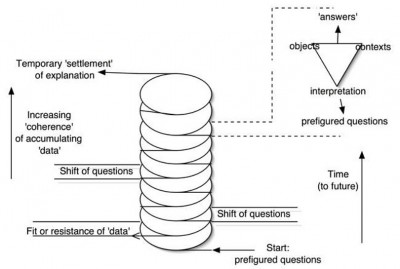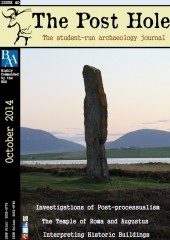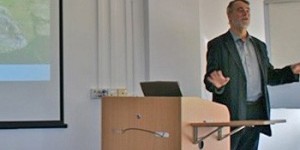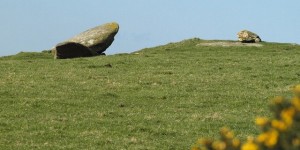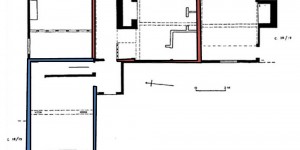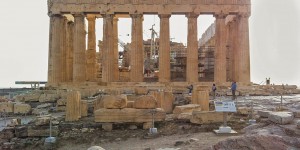The majority of postprocessual archaeology is compatible with science. To justify this statement the demarcations of science must be studied to show that the structure of the theoretical school fits with the scientist’s template of study (Geuss 1981, 2, Green and Moore 2010, 253, Johnson 2010, 102-110, Preucel 1995, 158, Shanks and Tilley 1992, 31-43, Thagard 1978 and VanPool and VanPool 1999). Therefore, the concepts of the Baconian inductivist approach and Popper’s falsification method, together with how they are used, must be investigated to ascertain the extent of the postprocessualist’s scientific character (Shanks and Tilley 1992, 41, Thagard 1978 and VanPool and VanPool 1999). We must also investigate how the principals of the fourfold Hermeneutic spiral can be seen as a self-aware progressive science superseding hypotheses in its structure (Hodder and Hudson 2003, 195-203, Johnson 2010, 106, Preucel 1995, 158, Shanks and Tilley 1992, 103-107 and VanPool and VanPool 1999). Principals of critical theory must be explored in order to show why postprocessual practice is more closely affiliated with science (Geuss 1981, 1-23). The misconstrued definition of objectivity must also be addressed (VanPool and VanPool 1999).
Objectivity is commonly viewed as the separation of self from the object of study; this definition was abandoned in the early 1950s and replaced with the definition that it should be testable across other social sciences and produce similar results (VanPool and VanPool 1999). Postprocessualism has viewed that objectivity (former definition) could not be reached because all hypotheses and data are theory-laden either through strong or weak social constructivism (Johnson 2010, 105 and Green 2002, 253). Even Popper himself is an acknowledged weak social constructivist with the view that observational statements are partially formed through theory (Shanks and Tilley 1992, 41). Therefore, it can be said that this view is scientific. However, the unwillingness of many processualists to accept that their data is comprised through a cloud of theory obstructs progression – which is unscientific. Postprocessualists have constructed the fourfold hermeneutic circle to aid in identifying subjective characteristics, understanding them, and using them to ensure that the present affects the view of the past as little as possible (Hodder and Hutson 2003, 195-203, Shanks and Tilley 1992, 103-107).
Progression is a key demarcation of science therefore, hermeneutics can be seen in a scientific light. Figure 1 clearly shows how there is a shift between theory and data to determine a temporary explanation which is supported by the data; this is then followed by a shift of question to determine new features of the object or characteristic being studied (Hodder and Hutson 2003, 195-203, Johnson 2010, 106, Shanks and Tilley 1992, 103-107). The spirals of hermeneutics clearly depict progress in the interpretations being developed through falsification. Older interpretations are abandoned for newer interpretations which better fit the data – therefore it is the use of scientific methodology to give an explanation of the artefact, both as a particular and in context, which is ultimately what processualists aim to accomplish. Therefore, this aspect of hermeneutics cannot be claimed as unscientific. However, to progress to fourfold hermeneutics we must understand the item in both the particular and the general, in both past and present; this separation will eventually merge together as more is understood about the item (Hodder and Hutson 2003, 196-197 and Preucel 1995, 158). This also involves understanding the influences of the interpreter, both theoretical and social, in order to determine any biases present (Hodder 1997, Hodder and Hutson 2003, 197 and Preucel 1995, 158). This is clearly an example of ‘critical self-consciousness’ (see. Clarke 1973). They are attempting to understand the structure of archaeological study in order to limit extraneous variables, clearly a scientific objective. However, due to the hyper-relativist’s phenomenological use of hermeneutics, which attempts to use the concept of understanding the object in both past and present to emulate past experience in the present to gain understanding, the whole concept of hermeneutics has been viewed as unscientific (see Hodder 1999, 132-133). Therefore, due to the scientific nature of the majority of postprocessual work perhaps the hyper-relativist methods should not be put under the same title. However, it must be recognized that most postprocessualists do not believe that anything can be argued for using hermeneutics (Hodder 1997).
The final point on hermeneutics is its relation to hypotheses. Hypotheses are predictions of what may or may not happen in a scenario which are then either integrated into knowledge or falsified (VanPool and VanPool 1999). However, this method may stunt scientific progress if it is used exclusively, particularly in archaeology. Archaeologists who have used this method have had an issue with equifinality, particularly those who use systems theory (Johnson 2010, 102). Therefore, an inductivist approach would not be successful due to multiple theories for the same phenomenon being viewed as credible. Similarly, a rigid falsification method is not suited for archaeological study either. This is due to the fact that young theories may be falsified due to our inability to collect the evidence (VanPool and Vanpool 1999). For example, the concept of early humans eating vegetation may have been falsified due to the evidence being unobtainable; however, due to examination of C12 and C13 analysis it is now possible and verifiable (Renfrew and Bahn 2000, 307-308 and Richards and Trinkaus 2009). If this interpretation had been falsified it would have led to a false construction of the past world, therefore these rigid methods are ineffective. Whereas, the more complex constructed interpretations produced by using the hermeneutic spiral would assess the specifics of the data regarding diet and put it in the context of where the hominids lived and the environment, therefore constructing a more realistic view. This raises a third issue: is it logical to construct a hypothesis based on a specific feature or activity? The idea of a hypothesis is to enable one thing to be tested specifically out of context to see whether the activity occurred. However, as seen above, taking archaeological data out of context is ineffective, therefore the hermeneutic method is more effective logically as well as in scientific respects.
Many would argue that postprocessualism is unscientific due to its inability to create universal laws (VanPool and VanPool 1999, Trigger 2006, 446). However, even though processualists began by constructing laws, this was shown to lack progression. Therefore, most processualists have focused on the production of generalized statements; there has been no specification of how generalized a statement must be to be considered scientific (Shanks and Tilley 1992, 32-34). Due to this lack of specification, even though the generalization of a statement may only be directed towards a single site, it cannot be considered unscientific. Processualism has also been considered unscientific due to its shift from the production of laws to the production of generalizations; however, it has been argued that there are two types of sciences: space-like sciences, such as physics which are more suited to the production of laws because the studied object is constant through time; and time-like sciences, which are less suited because through time the observed object changes (VanPool and VanPool 1999). It is clear that archaeology falls into the latter category which is less suited to the production of laws; this is due not only to evolutionary change, but also social change which may lead to different uses of objects – this can be furthered by stating that not only does the object change through a longevity, but also through the unpredictable and inventive nature of the human brain, which may cause objects to be used for secondary (or more) purposes which were not predesigned and are therefore less obvious.
Subsequently, it is clear that archaeology must abandon the productions of laws because it is not progressive.
To ensure that the postprocessual method fits with scientific principals we must study the demarcations themselves. The most accepted view of science in archaeology is the ‘legendary view’, which dictates that it must be logical and objective, with meticulous recording, rational hypotheses, evaluating all possibilities and falsifying theory when a better interpretation is developed, without influence (VanPool and VanPool 1999). As we have seen above, hypotheses are not an effective way to conduct archaeology; however the demarcation of rationality may allow for this. The meticulous recording of data is clearly demonstrated in moderate postprocessualism due to the need for theories to withstand scrutiny. However, we do come to two key issues when using the ‘legendary view’. Firstly, postprocessualists believe that all interpretation is influenced by the present; however, as stated above, their acceptance of this has led to the production of fourfold hermeneutics as a scientific solution. The second issue is that postprocessualists do not have to falsify their theory if a more compatible theory is produced, or even if the data does not necessarily fit (VanPool and VanPool 1999). Yet, if this is the case then it makes the theory unlikely to withstand scrutiny and it is not accepted by the whole community. Therefore, it is still progressive. Instances of this have been seen in the recognized scientific community; for example, the principals of natural selection are not falsified even though evidence of communal activity goes against the theory (VanPool and VanPool 1999). Another reason these interpretations are not falsified may be due to the complex nature of humanity which leads to a hierarchy of meanings (VanPool and VanPool 1995). Subsequently, multiple interpretations may in fact be valid. Thagard’s (1978) view of science may be more appropriate. He viewed that something became unscientific if it was less progressive than other theories over a long span of time, made little attempt to solve problems, held no concern to evaluate the theory and was selective in the data they used; the example he used was astrology, which does not produce theories which if falsified disprove the core theory and has struggled against all of these demarcations. Moderate postprocessualism, when analysed using these categories, clearly is scientific. However, hyper-relativism is not (another reason to split the two groups under different headings). Postprocessualism has faced no issues in, ‘community, theory or historical context’ which would, in Thargard’s analysis, suggest it being a pseudoscience. Even though the ‘legendary view’ has a few demarcations which are not met, these are abandoned for rational reasons (which is a demarcation in itself) and postprocessualism is fully supported by Thagard’s principals of science – therefore, it would be counterproductive to name it unscientific.
The question we must address is why postprocessualism should not be considered as a critical theory? The main issue is that critical theory is supposed to study human behavior in order to enlighten and free agents from self-imposed constraint (Geuss 1981, 2). I would argue that in this sense postprocessualists use critical theory but would not be accepted by the Frankfurt school as a solely critical study. The use of fourfold hermeneutics is clearly a form of critical theory in the sense that it educates the practitioners (or agents) in what may be influencing their work so that they may restructure their studies to limit the effects of these influences. This is a clear use of ideology in the positive sense (Geuss 1981, 22-23). However, it may be argued that this is one of the few instances of critical theory being used in postprocessual study. There has been a shift in postprocessual archaeology to being more reflective than objective, which could be argued to originate in their study of meaning. However, the meaning of objects influences the interpretation of other objects therefore, it is vital. It could also be argued that processual archaeologists were searching for explanations which originate in many cases from meaning. Therefore, to progress descriptive sense to a pejorative sense, meaning must be understood, otherwise archaeology may be “overwhelmed by impossible theories or a welter of flint chips” (Murray 1961, 13). For that reason the reflective study has grown from a scientific origin. Postprocessual study is clearly more closely linked with scientific study than critical theory and merely uses it to limit extraneous variables in their work to increase internal validity.
Finally, to truly claim that postprocessualism is a science, we must assess how it is a progression over processualism. We must recognize that, despite their wishes to be explanatory, it is strictly descriptive. This is seen from the beginnings of processualism (Hawkes 1954). It has also been criticized that it has limited itself so much so that it is only able to study certain aspects of the archaeological record, in particular those at the base of Hawkes’s ladder of inference such as production and subsistence techniques (Lucas 2012, 136, Taylor 1948 cited in Hawkes 1954). In defense it has been claimed that archaeology is merely the study of material remains and that aspects such as sociological, religious and mental issues are anthropological (MacIver 1933). However, this is clearly untrue as presented by Kintigh (2014) which includes communal and cognitive issues in its twenty-five challenges for archaeology. The final issue is that processualism regards human behaviour as determined by natural change in a formulaic manner (Dornan 2002, Green 2002, 253, Hodder 1999, Hodder 2007, 2, Shanks and Hodder et al. 1995, 4 and Trigger 1989, 445). The postprocessual view is that there are multiple effectors which lead to social change; that range from societal and individual to environmental stimulators, therefore creating a less reductionist and deterministic formula for change, which is a clear progression (Dornan 2002, Hodder 1999, 129-132). Secondly, instead of limiting study to lower rungs of Hawkes’s ladder of inference, postprocessualism is using scientific method in order to gain a better understanding of the higher rungs of the ladder of inference. For example, Hodder (2007) found a cache of bear claws and used the religious context of the site (the already established Bull cult discovered by Mellart (1961)) to suggest that there had already been a bear cult at the site. However, another success of postprocessualism is the constant reinterpretation in order to search for better fitting theories meaning the theory will constantly be re-tested, therefore showing the scientific characteristics similar to those in processual analysis of flint-knapping but in relation to culture. This shows that postprocessualism is a scientific progression to study the aspects of society which are not covered by the limited sphere of processualism.
In conclusion, the demarcations of science support the claim that the majority of postprocessual study is scientific. However, there is a minority of hyper-relativists which are not scientific and therefore should be regarded as a second theoretical group. The criticisms of postprocessual study are founded on outdated definitions and criticisms based on extreme hyper-relativist study and therefore do not apply to the majority of practitioners. The use of the hermeneutic spiral can also be seen in a scientific light as a more logical approach which avoids many faults which may be incurred when studying human behavior using hypotheses, such as a lack of context and issues with equifinality. Therefore, postprocessualism is a scientific method which uses the hermeneutic spiral in a scientific way in order to progress further and faster in creating a view of the past world which relates to all aspects of the ladder of inference, with more reliability due to fourfold hermeneutics than other scientific methods.
Bibliography
- Clarke, D. L. (1973). Archaeology: the loss of innocence. Antiquity. 47, 6-18.
- Dornan, J. L. (2002). Agency and archaeology: Past, present, and future directions. Journal of Archaeological Method and Theory. 9(4), 303-329.
- Geuss, R. (1981). The idea of a critical theory: Habermas and the Frankfurt School. Cambridge University Press.
- Greene, K., & Moore, T. (2010). Archaeology: an introduction. Routledge.
- Hawkes, C. (1954). Archeological theory and method: Some suggestions from the Old World. American anthropologist. 56(2), 155-168.
- Hodder, I. (2007). Excavating Çatalhöyük: south, north and KOPAL area reports from the 1995-99 seasons (Vol. 37). McDonald Inst of Archeological.
- Hodder, I. (1997). Relativising relativism. Archaeological Dialogues. 4(02), 192-198.
- Hodder, I. (1999). The archaeological process: An introduction. Oxford: Blackwell.
- Hodder, I., & Hutson, S. (2003). Reading the past: current approaches to interpretation in archaeology. Cambridge University Press.
- Johnson, M. (2010). Archaeological theory: an introduction. John Wiley & Sons.
- Kintigh, K. W., Altschul, J. H., Beaudry, M. C., Drennan, R. D., Kinzig, A. P., Kohler, T. A., Limp, F. W., Maschner, H. D. G., Michener, W. K., Pauketat, T. R., Peregrine, P., Sabloff, J. A., Wilkinson, T. J., Wright, H. T. and Zeder, M. A. (2014). Grand challenges for archaeology. PNAS. 111 (3), 879-880.
- Lucas, G. (2012). Understanding the archaeological record. Cambridge University Press.
- Murray, M. (1961). First steps in Archaeology. Antiquity. 35(137), 8-13.
- Preucel, R. W. (1995). The postprocessual condition. Journal of Archaeological Research. 3(2), 147-175.
- Randall–MacIver, D. (1933). Archaeology as a Science. Archaeology. 7(25), 5-21.
- Reconfiguring the Archaeological Sensibility: Mediating Heritage at Teotihuacan, Mexico. (2009). Epistemic Settlements: 'guarded objectivity’. [Online]. Available at: http://humanitieslab.stanford.edu/30/1119. Accessed on: 01/04/2014.
- Renfrew, C., & Bahn, P. 2000. Archaeology: Theories Methods and Practice.
- Richards, M. P., & Trinkaus, E. (2009). Isotopic evidence for the diets of European Neanderthals and early modern humans. Proceedings of the National Academy of Sciences. 106(38), 16034-16039.
- Shanks, M., & Tilley, C. Y. (1992). Re-constructing archaeology: theory and practice. Psychology Press.
- Thagard, P. R. (1978). Why astrology is a pseudoscience. PSA: Proceedings of the Biennial Meeting of the Philosophy of Science Association. 223-234.
- Trigger, B. G. (1989). A history of archaeological thought. Cambridge: CUP.
- VanPool, C. S., & VanPool, T. L. (1999). The scientific nature of postprocessualism. American Antiquity. 64(1), 33-53.


